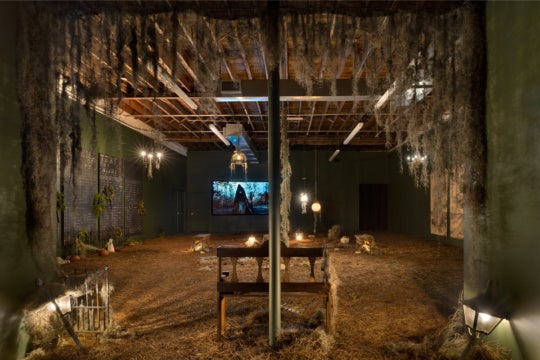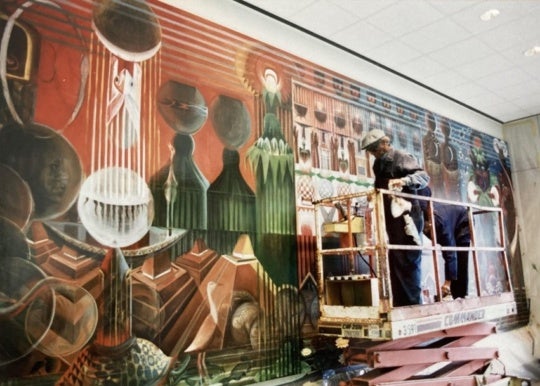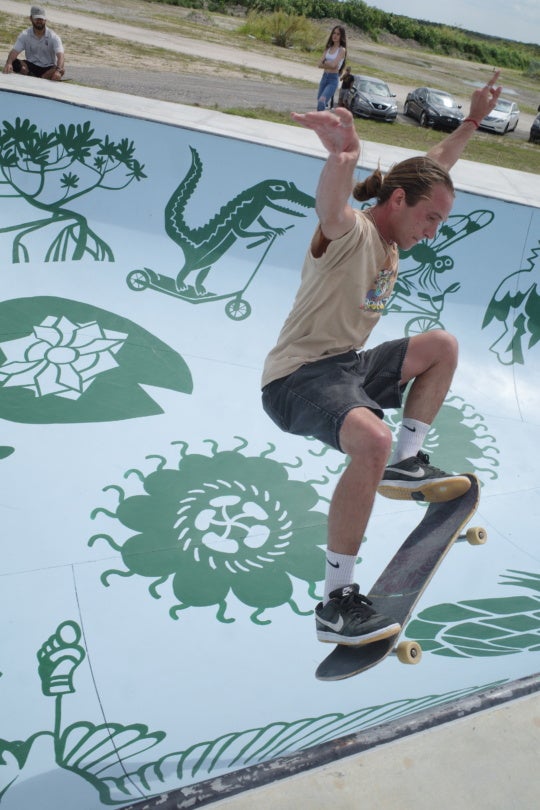Initially, it seems that Atlanta-based artist Katherine Taylor’s current exhibition at Marcia Wood Gallery sticks close to familiar territory. Many of the artist’s visual tropes make their appearances in these paintings: expertly blurred landscapes, effortless illusions of space, a nuanced and largely neutral palette—these are a few of her favorite things. All this, coupled with Taylor’s masterful and lingering sense of the human (consistently evoked without literal depictions of the figure) would make for another solid outing in a steadily growing list of strong exhibitions. A closer look at Firmament, however, reveals recent formal and material innovations which further complement the scope of Taylor’s project, and push the language of her skilled paint-handling up to and inside the edges of abstraction.
Upon entering the gallery, viewers are initially greeted by several groupings of uncharacteristically diminutive pieces. Each composition is sharply divided by a severe horizon line, which immediately establishes the worn look of a landscape that characterizes much of Taylor’s work. At moments, it is only this horizontal that communicates our knowledge of landscape. These new works up the ante in the artist’s mark-making—thick smears and scrapes of oils sit shimmering on top of smooth and blurred indications of place; our locations, initially anonymous, are given a new form of specificity by the artist’s hand. Paradoxically, it’s the slabs of still-wet looking paint that allude openly to the decay of the landscape itself, that unfortunate and inevitable mark of the human. Tactile scars compete with unblemished fields in a visual rivalry not unlike the antagonism of our relationship to the landscapes we inhabit, as well as their unyielding retaliations against us.

Several of the most affecting paintings in the show rotate views on the same emptied and dirtied swimming pool, a motif so unusual that it more than merits the multiple discussions Taylor brings to it. Positioning the viewer at various distances, two metal handrails serve as a key entry point into an environment at once so completely still and so completely active, as frantic, skittering tracks of pigment race across otherwise unoccupied surfaces. It’s these swimming pool works that epitomize much of the binaries that Taylor’s paintings tread throughout the entirety of Firmament: stillness and frenzy, silence and clamor, and the actual against the potential.

Several of these works, surprisingly, are executed on aluminum sheets. The slick surface of the substrate is more than appropriate for Taylor’s consistent blurring of edge, a technique that one cannot mention without also mentioning Gerhard Richter; however, the overt tenderness of Taylor’s handling, as well as her considerable ability to conjure empathy from the sparest of means, mark a distinction between her conceptual goals and those of the venerated (but decidedly chilly) German painter. Katherine Taylor’s thorough and ongoing relationship with her content—namely, the shifting and mercurial relationships between humans and place—position within her work strains of environmentalism, or some form of visual activism. But it is her treatment of her subjects—sparing, unsentimental, moral—that move her painting into the terrain of the best kinds of poetics. This is great stuff.

Next door, an emphasis of the material is thoroughly present in Fetish, an exhibition of nearly uncategorizable works by Louisiana artist Shawne Major. To describe Major’s complex tapestries as “mixed-media assemblages”—perhaps the most immediate descriptive phrase—is to do them a tremendous disservice. It would be more adequate to describe them as downpours of objects; so overwhelming are their physical and material presence that to be alone in a room with them is to not be alone at all.
By hand-quilting multiple layers of fabrics, re-purposed clothing, children’s toys, Christmas lights, costume jewelry, tulle, pantyhose, extensions cords, plastic souvenirs (and so on, and so on…) Major’s wall hangings operate on several levels simultaneously. My initial reaction was one of awe for the sheer commitment to process that the artist must bring to each work—when viewing these pieces up close, Major’s tenacious hand-stitching is fast and furious, literally holding all of these elements together. From a distance of several feet (the most chaotic viewing position) the materiality and individual identity of the elements themselves overwhelms. However, when seen across a room, Major’s myriad compositional strategies create an image from the clutter openly referencing more traditional painting techniques. Criss-crossing linear elements create a geometric abstraction from a cool-colored square of Nadir. Next to this, miniature plastic traffic pylons sewn into Poly-Haptic reference aerial views of mountain tops, or frontal views of bodily orifices. In the center of the space, a medium-sized ice-cream cone crash lands on its pedestal.

This may be one of the most engaging aspects of Major’s work, and I mean this sincerely: when considering her many objects individually, a lot of this stuff is crap. By that, I’m referring to the things that collect in your closets (almost autonomously) over time, or the many cords that you shove behind bookshelves because they’re so distracting from what you really want people to look at. Or, as in the case of Sub Rosa Subduction the many bags of glow-in-the-dark stars that could be in the bargain bin at the Dollar Tree. This is Major’s real genius, a sensibility not unlike the short stories of Raymond Carver, or the late works of Phillip Guston; the kind of vision that lines each and every cloud with the finest of silver, and a commitment to the extracting of diamonds from the rough.
Firmament and Fetish will be on display until March 10, 2012. Katherine Taylor will speak to the public about her work from Noon to 1PM on Saturday, February 18 (a schedule change from the initial date of March 3).




